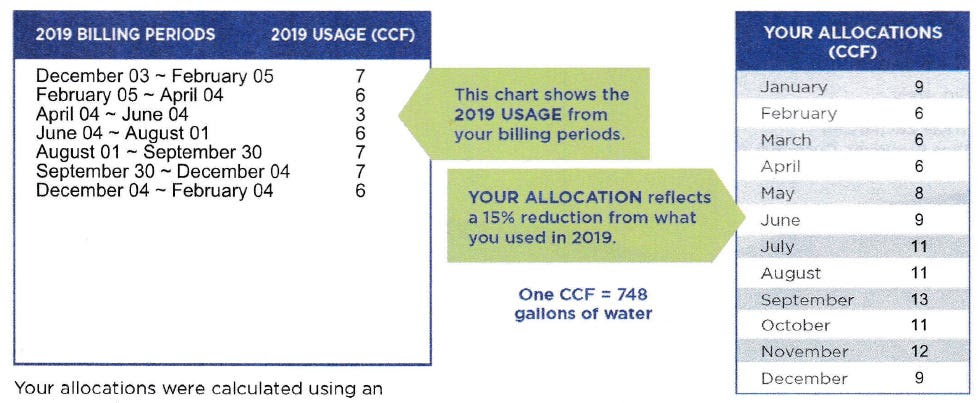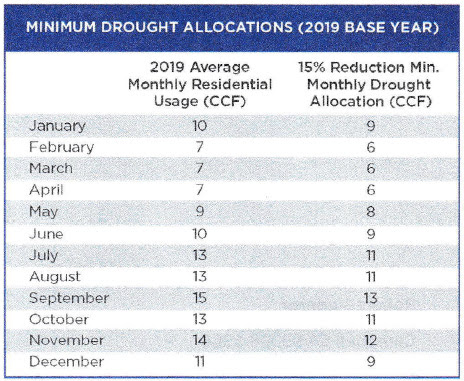
from the desk of Bob Siederer
Hello again Science Fans!
I fully realize that with a subject line/title such as the one I wrote this week, I run the risk of shooting myself in the foot with an unclear editorial today. Ah, the risks we take…
As I’m sure you know, California faces a serious drought condition. While the rain and snow we received so far has lessened the severity, the drought is far from broken. So we’re under water use restrictions that call for a 15% reduction in water usage compared to our 2019 usage. So far, so good.
But who knows what their 2019 water usage was? Show of hands? And even if you did, how would you know if you were using less now? Consulting your bill would be after the fact and you can’t put water back in the tap.
So a few weeks ago I got a letter from San Jose Water, my water utility. If they supply your water, you probably got one too. It showed how much I used in 2019 and what my allocation would be for 2022, based on a 15% reduction. Just the information I was looking for! Or was it?
Here’s what it showed:

First off, on the left it shows my 2019 usage in roughly 2 month periods, matching my billing periods, while showing my allocations for each month on the right. The periods don’t match, so we have an apples and oranges comparison right off the bat.
The units of measure are in CCF. Nowhere in the letter does it tell me what CCF means. So I turned to Google. The first C stands for the Roman numeral for 100, believe it or not. The remaining letters stand for cubic feet, so 100 cubic feet = 1 CCF. The letter DOES define 1 CCF as 748 gallons of water, something I can finally relate to, sort of, except I have little concept of just how big 748 gallons, or 100 cubic feet (or 6,230.84 pounds for that matter) of water is.
Next, the letter says my allocation reflects the 15% reduction that will be imposed. Yet the numbers on the right showing my allocation per month (not per billing period) are all larger.
Further down on the page is this table:

There’s a minimum amount per month below which you won’t be cut, and that amount is larger than what I used at any point. The column on the right matches the allocation allowance in the previous table.
That was clear, wasn’t it? They couldn’t just say “since your usage was less than the minimum, don’t worry”?
I was reminded of the importance of clarity just today when I read that way back in 1845, on this date, Congress passed a law setting Federal Election Day as the first Tuesday after the first Monday of November. That means November 1st can’t be election day. Why? What is so special about November 1st that it can’t be election day? A Sugar coma from Halloween the night before? All Saints Day?
It turns out it is more mundane than that and is related to our agrarian society, the harvest, going to church on Sunday, and travel to the county seat to vote. Here’s the full explanation.
We’ve talked here many times about the importance of clear communication in science. As I researched articles for this week’s Schmooze, I came across more examples where clear communication would improve things.
One area deals with COVID-19, of course, where various studies are quoted on a daily basis to either support or refute the writer’s point of view. Booster shots fight off Omicron. Booster protection wanes after 10 weeks. A fourth booster is only partially effective.
We’re now told we should be wearing N95 or KN95 rated masks instead of cloth masks to fight Omicron. Back when masks were first being called out, N95s were in short supply and were being restricted to medical use. Now they are more plentiful. Here’s why they are better.
Most times when omicron is mentioned, it coincides with language along the lines of it being milder, or not as serious, as previous strains. I’ve even heard of people saying they want to be exposed to omicron to get it over with. Your definition of “mild” and health professionals’ definition probably are not nearly the same.
Another area of science where clear communication is critical is sex. Yet our sex education is anything but clear, detailed, uniform, or even accurate. It varies greatly depending on which state you live in. I recently came across a YouTube channel by sexologist Dr. Lindsey Doe. She is one of those rare people who can communicate science clearly, with humor, and without embarrasment. Her channel began in June, 2013 and I highly recommend it. I’m about half way through watching her short videos and have learned a lot.
I’m sure you have seen emails and other communications where the signature area contains a list of pronouns the writer wishes to be used to identify themselves. You may have wondered, like I did, what is behind this movement. Dr. Doe has several short videos on the subject of non-binary sexual identification and the science behind it. Now I’m educated!
I’ve also skipped ahead and I’m distressed and angry about what I found.
Dr. Doe has been harassed by people who don’t share her views, or who just don’t like the subject matter in general, to the point that she shut down her channel at the end of 2021 and had to move out of the US for her own physical and mental health. That’s plain awful, and I’m sorry that the political and social climate in this country is such that she was driven to take this extreme action.
On to other science news…
The Tongan undersea volcano eruption appears to be much larger than the largest nuclear detonation ever conducted, by a large margin. There’s nothing nuclear about the volcano, but in terms of energy released it was enormous. And echos of the shock wave are still traveling around the planet and into space.
No doubt you’ve read or heard about issues with 5G cell phone service and airports. Why are airlines canceling some flights and pushing back on the deployment of 5G around some airports? The short answer is it has to do with radio altimiter interference. It has nothing to do with the deployment of 5G and the concurrent spread of COVID. But that has not stopped conspiracy theorists from burning down 5G towers.
Ever wonder what it would be like to be a penguin and swim through a school of sardines?
On Monday, the James Webb Space Telescope will reach L2, the point in space where it will assume an orbit. The telescope’s mirrors have deployed successfully. Live coverage of the arrival at L2 should be available from NASA here. The next step, after reaching L2, is for scientists to fine tune the allignment of the mirrors, a process that will take some time. Congratulation are in order to all the folks who worked long and hard to make this mission a success so far.
On Mars, Perseverance has taken care of some toublesome pebbles and is back in action. Meanwhile, the Ingenuity helicopter had to remain grounded due to inclement weather. Flight delays are now a thing on Mars too.
Closer to home, the dark side of the earth’s moon is covered with sticky soil and fresh craters, discovered by China’s Yutu-2 rover.
The Solar Dynamics Observatory captured images of a very large solar flare this week. An animation leads the Schmooze.
Lastly, the Telescope Makers Workshop, one of only a handful of regular telescope making workships in the US, resumes this Friday, January 28 at Chabot Space and Science Center in Oakland. If you or someone in your family is interested in building their own telescope, this might be the project to start them on a journey of exploration. The workshops are free, but materials cost up to $200, depending on the size of the mirror. This isn’t listed on Chabot’s website (yet) so contact Richard Ozer directly if you are interested (richozer1@gmail.com).
Please support science education and clear communication. And in the words of Dr. Lindsey Doe, “Stay Curious”.
Have a great week in Science.
Bob Siederer

